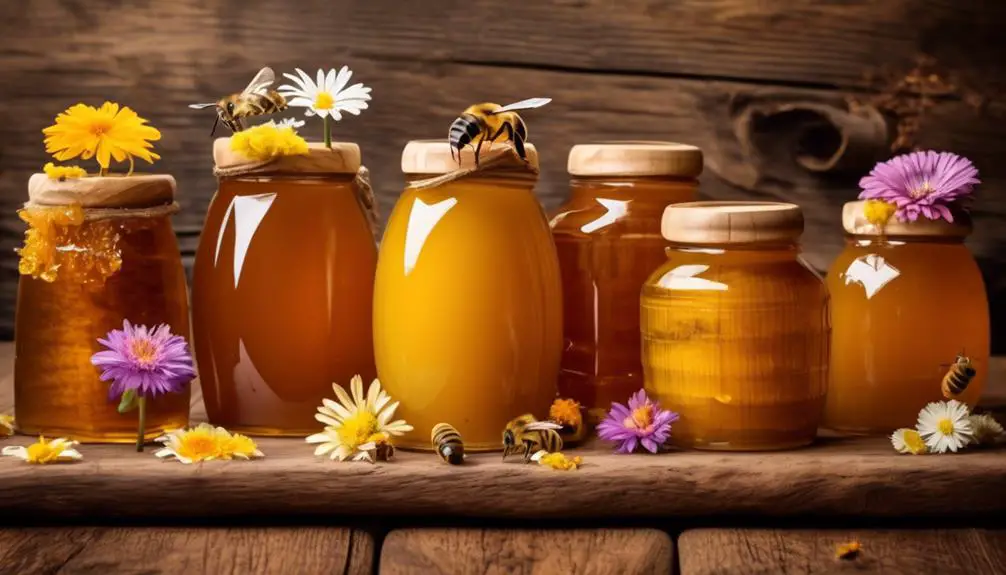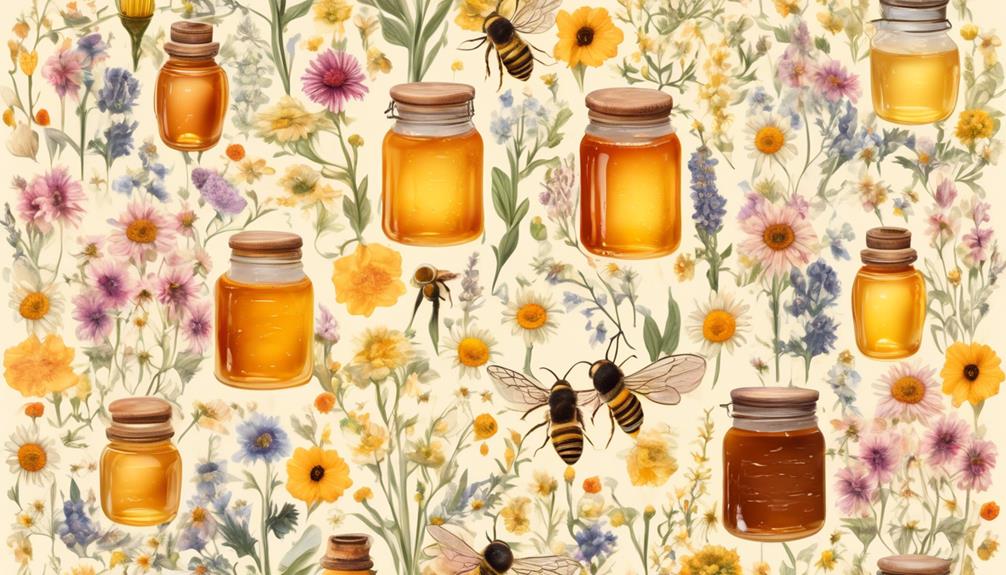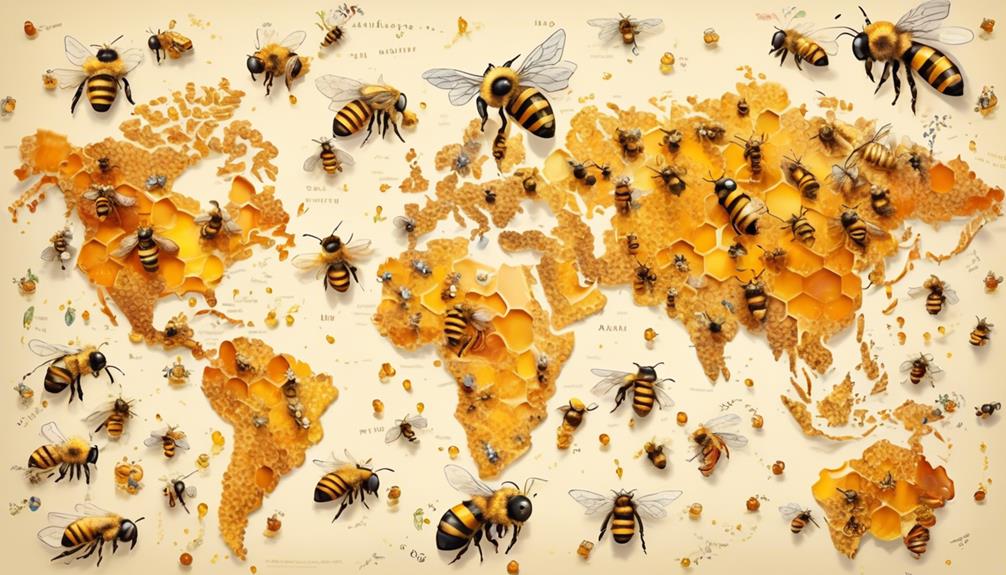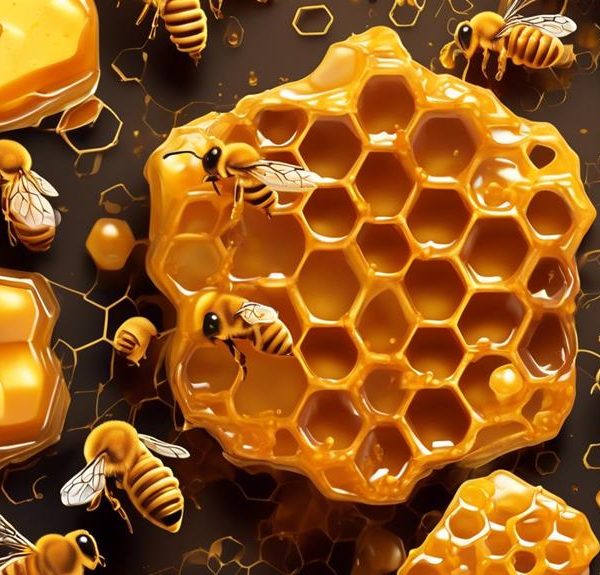Journey into the diverse world of honey, discovering the 300 unique types found in the United States and the factors influencing their variety.

Are There Different Types of Honey
Did you know that there are over 300 unique types of honey available in the United States alone? That's quite an impressive variety, isn't it?
You might have thought honey is just that sweet, sticky substance you spread on your toast or stir into your tea. But, in reality, it's a complex product of nature with a diversity that's influenced by factors like the species of bees, geographical location, and the type of flowers bees visit.
As you explore this topic further, you'll discover the intricate world of honey, its fascinating variations, and why they matter.
Key Takeaways
- There are over 300 unique types of honey in the US, each with distinct flavors and characteristics.
- Different bee species, including honeybees, bumblebees, and stingless bees, contribute to honey production, influencing levels and composition.
- Geography plays a significant role in shaping the taste, color, and consistency of honey, with local flora, climate, and soil types impacting honey properties.
- Various types of honey offer specific health benefits, such as antibacterial properties in Manuka honey, high antioxidant content in Buckwheat honey, and low glycemic index in Acacia honey.
Understanding Honey Varieties

Diving into the world of honey varieties, you'll discover a spectrum of flavors, colors, and textures that are influenced by the types of flowers bees visit. This versatility is due to the nectar that bees collect, which determines the honey's unique characteristics.
You'll find that clover honey, a popular variety, has a light, mild flavor and a translucent color. Buckwheat honey, on the other hand, is robust and dark, with a taste that's reminiscent of molasses. There's also wildflower honey, which is typically darker and has a more complex flavor profile due to the variety of flowers visited by the bees.
The texture of honey varies too. It can be liquid, creamy, or even crystallized. The crystallization process is natural and doesn't affect the quality or flavor. In fact, it's preferred by some as it's easier to spread.
Understanding these varieties helps you better appreciate the hard work bees put into each jar. It's also beneficial when pairing honey with different foods and beverages, as the right match can enhance flavors wonderfully. So, don't be afraid to experiment and find your personal honey preference.
The Role of Bee Species

While the types of flowers bees visit influence the taste, color, and texture of honey, it's also essential to recognize the role of different bee species in honey production. Not all bees can produce honey. Honeybees, as their name suggests, are the primary honey makers. They're well-known for their social behavior, complex hive structure, and, of course, honey production.
But honeybees aren't the only species involved. Bumblebees, stingless bees, and some solitary bees also produce honey. However, their production levels are significantly lower, and their honey's composition differs. For example, stingless bees, common in tropical climates, produce a slightly sour, thinner honey that's highly prized in some cultures.
Also, consider the role of the Africanized bee, a hybrid of European and African honeybees. They're known for their aggressive defense of hives but also for their superior honey production.
Geographic Influence on Honey

The geography of a region plays a pivotal role in shaping the unique characteristics of its honey. You'll be amazed to see how location can influence the taste, color, and consistency of this sweet delicacy. The local flora available to bees is a primary factor, as the nectar they collect directly impacts the honey's properties.
For instance, honey from a lavender-rich region in Provence, France, will have a distinct, floral aroma and taste that's different from the robust, molasses-like flavor of buckwheat honey from New York, USA.
Climate, too, is a significant influence. The temperature and rainfall in a region can affect the types and quantities of flowers available to bees. Honey from tropical regions, blessed with year-round blooms, may differ greatly from that of temperate zones with distinct seasons.
Soil types influence the plant species that thrive in a region, and in turn, the honey produced. For example, honey from regions with chalky soils, like the UK's South Downs, may have a different profile than that from the clay soils of the American Midwest. Remember, each jar of honey is a reflection of its geographical origin, a true taste of the landscape.
Health Benefits of Different Honeys

Beyond their delightful taste and texture, different types of honey carry a range of health benefits that you might not be aware of. The nutritional composition and health benefits of honey can vary significantly, depending on the floral source.
Manuka honey, for instance, has superior antibacterial properties that can help with wound healing. It's a good choice if you're looking to boost your immune system. Buckwheat honey, on the other hand, is rich in antioxidants, which can help protect your body from damaging free radicals.
Honey Type | Health Benefit |
|---|---|
Manuka | Superior antibacterial properties |
Buckwheat | High antioxidant content |
Acacia | Low glycemic index, good for diabetics |
Clover | Anti-inflammatory properties |
Acacia honey is known for its low glycemic index, making it a healthier choice for diabetics. Lastly, clover honey has anti-inflammatory properties, beneficial for those dealing with inflammation-related conditions.
Popular Honey Types Worldwide

Having explored the health benefits of different honeys, let's now turn our attention to some of the most popular types of honey enjoyed by people worldwide.
Firstly, there's Clover honey, a common variety adored for its sweet, floral taste and light color. It's frequently used in baking and cooking. Next, Manuka honey from New Zealand is renowned for its antibacterial properties and distinctive flavor.
Acacia honey, known for its clear, almost transparent color, is beloved for its sweet, delicate flavors. It's perfect for sweetening beverages without altering the taste. Buckwheat honey, darker and richer in flavor, packs a nutritional punch with higher antioxidant content.
Then there's Orange Blossom honey, a product of bees who've feasted on citrus flowers. Its sweet, fruity notes make it a breakfast favorite.
Sage honey, with its delicate, mild taste and beautiful golden color, is a hit among honey enthusiasts. It's also known for its slow crystallization process, which keeps it liquid longer.
Lastly, let's not forget Wildflower honey, a type that varies widely in flavor and color. Its taste and aroma reflect the myriad of flowers visited by the bees.
Each honey type offers a unique tasting experience, reflecting the diversity that nature has to offer.
Conclusion
Indeed, there are diverse types of honey, influenced by bee species and geographic location. These varieties not only offer unique flavors but also distinct health benefits.
From Manuka's antibacterial properties to Acacia's gentle composition, the world is buzzing with honey options.
So, next time you're sweetening your tea or drizzling over a dish, remember: you're not just choosing honey, you're selecting a world of flavor and health benefits.
Explore and enjoy the richness of honey's diversity.


